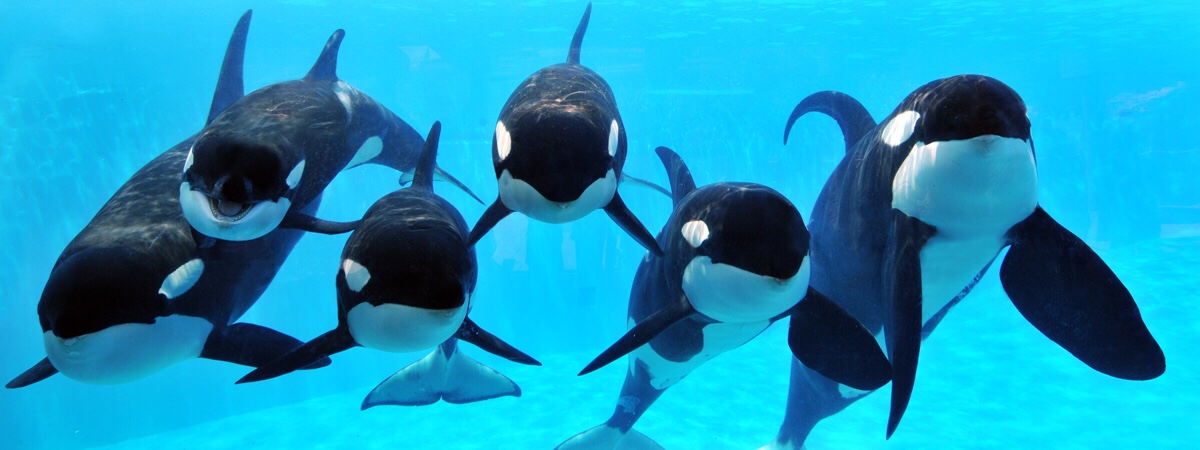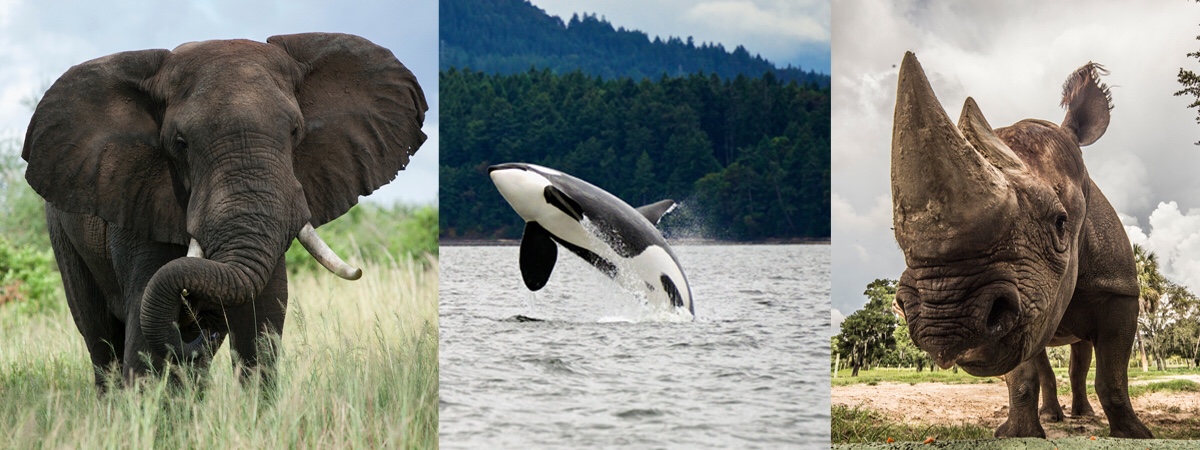
Last week, as a Southern Resident killer whale (SRKW) mother was photographed off the Washington state coast pushing her deceased newborn toward San Juan Island, a heartbreaking glimpse into the plight of this endangered killer whale population in the wild, a British travel company made a ham-fisted announcement that somehow in the name of “animal welfare” it will no longer sell tickets to zoological parks that display killer whales.
Widespread condemnation of the move was swift as other travel companies and the zoological community noted the irony of the company banning ticket sales to the two leading accredited and humane-certified parks that contribute so much to scientific research, education and conservation work to protect killer whales in the wild. The CEO of another travel company criticized the decision, calling it “misguided” and noting that “…there are bigger and better fights to be had that would have an impact on animal welfare….” He was right.
Meanwhile, as the SRKW population of only 75 has continued to dwindle (the dead calf was the first to be born in three years), scientists at SeaWorld were conducting research on their killer whales’ milk composition to understand the nutritional requirements for mothers and calves to determine if prey availability is sufficient to meet the nutritional needs of killer whales in the wild, information that is critically important because, as the Associated Press has noted, “…they’re not getting enough of the large, fatty Chinook salmon that make up their main diet.” In fact, scientists that study the SRKW population, like Ken Balcomb from the Center for Whale Research on San Juan Island, believe aggressive measures are needed to save the endangered population such as removing up to four dams on the lower Snake River to restore salmon runs.
The death of a newborn orca this past week is not an isolated incident for this endangered killer whale population. In the past month, a four-year-old juvenile that was part of the 2014-2016 SRKW “baby boom” was observed by field researchers to be severely emaciated. Of the 11 calves born during that hopeful time, less than half remain alive today, and scientists don’t expect this juvenile to survive. This only underscores the need to continue to fund research and implement meaningful conservation measures to help wild orcas, work that is undermined by the decision of this travel company to phase out ticket sales by next summer to parks doing work that could help save this population.
Scientific investigation of adult and calf nutritional requirements is just part of SeaWorld’s $10 million pledge to fund research and other conservation activities for killer whales, the largest private commitment of its kind. Other risks to cetaceans include toxins possibly transferred during pregnancy and lactation to offspring that may be causes for reduced pregnancy success and increased health issues in wild killer whales. Researchers were also studying pregnancy and lactation on SeaWorld’s killer whales to understand how the whales metabolize toxins—that is, until pressure from animal rights activists forced SeaWorld to stop breeding its killer whales, bringing an incomplete end to this important research.
The other park impacted by the British travel company’s decision, Spain’s Loro Parque, also contributes to orca research in the areas of bioacoustics, diet, and environmental contaminant effects in wild killer whales, including research on the potential effects of toxins on reproduction and validating a new method of sonar technology to remotely measure body dimensions of wild whales, to name just a few of the recent and ongoing research projects supported by patrons of this world-class facility through their admissions tickets.
In truth, zoos and aquariums are among the major funders of in situ and ex situ conservation projects and research that benefit a wide range of animals in the wild. Several critically endangered species have increased their populations through zoo and aquarium breeding programs, including the California condor, the black-footed ferret, the whooping crane, and the Arabian onyx. Zoos and aquariums also rescue and rehabilitate thousands of sick and injured animals in the wild each year, giving permanent homes to those that can’t be released back into the wild. The education and conservation messages of zoos, aquariums and marine parks reach millions of people each year. Their popular interactive programs help facilitate a powerful human-animal bond that inspires visitors to want to help conserve animals in the wild. And zoological training professionals develop and share science-based animal husbandry and best practices, work hard, and make real sacrifices with their personal lives to ensure the animals in their care have amazing, enriched lives and the best possible welfare.
These positive conservation outcomes are possible because of revenue generated through visits to these and other zoos, aquariums and marine parks each year. Yet a travel company pressured by activists apparently thinks it’s helping animals with its decision to stop selling tickets to zoological facilities that exhibit species to which it objects—even when those institutions passed with flying colors animal welfare inspections based on the animal rights-activist-inspired criteria the company itself embraced, and even though that same company has no zoological knowledge or expertise.
Both impacted zoological institutions are in fact accredited by long-standing, more experienced, knowledgeable and respected accrediting and certification bodies, including the Alliance of Marine Mammal Parks and Aquariums, the American Humane Association, the Association of Zoos and Aquariums, and others. They didn’t need the extra validation from the new travel certification recognized by this company, but they willingly subjected themselves to it in the spirit of good will because they are proud and confident of their animal care and welfare standards and have nothing to hide. Not surprisingly, the parks passed the required 100 percent on their inspections, only to be rewarded with the surprise announcement by the travel company that ticket sales to their parks would be dropped beginning next summer.

The fact is that zoos, aquariums and marine parks are helping to save species, and the response of this travel company to misguided activist pressure harms the ability of these institutions to continue to do their critical conservation work. Regardless of the travel company’s latest concession, animal rights groups will continue to pressure it to do more, continually moving the goalposts for the actions they demand from the company. While this decision was about parks that display orcas, the next pressure point, as activists have made clear in their recent social media posts, will be about parks that display dolphins, and after that just about any other species displayed in a zoo, aquarium or marine park to which they object. Ironically, many animal rights activists especially oppose “shows” and interactive activities with animals that help facilitate a powerful human-animal bond, the very activities that most inspire people to want to help and conserve animals in the wild.
The philosophical battle lines have been artificially drawn by a minority of people with a disproportionately loud social media voice. That doesn’t mean most people in any country embrace their extremist views, because they don’t. Seven-hundred-million people a year vote with their feet by visiting zoos, aquariums, and marine parks. Although animal rights activists denigrate their motives as being inspired merely by what they deem as lowly human “entertainment,” visitors tell us they seek inspiring, educational, and informative visits for themselves and their children, and our accredited member institutions do everything they can to fulfill those desires. As a result, visitors leave zoos and aquariums having had transformational experiences with animals they could never otherwise encounter, educated about them and their plight in the wild, and inspired to want to help conserve them.
This is where zoos, aquariums and marine parks serve as arks of conservation and public inspiration at a critical point in history, when an unprecedented number of species and their habitats are at risk of extinction. If we want our zoos and aquariums to be able to continue their unique and critical education, scientific research, rescue and rehabilitation, and other conservation work, now is the time to support them, not only with visits and donations, but in the misleading public debate activists have generated about the very legitimacy of the existence of zoos and aquariums. That means continuing to inform ourselves about the high standards and work of accredited zoos and aquariums, looking critically at the allegations made by anti-zoo groups, voting with our feet and wallets by visiting them, and weighing in on public policy debates that would restrict the work of, and species displayed by, these important institutions. The future of zoos and aquariums, and your children’s or grandchildren’s opportunity to visit them down the road, as well as wildlife itself just may depend on it.
Kathleen Dezio is president of the Alliance of Marine Mammal Parks and Aquariums. Grey Stafford is president of the International Marine Animal Trainers’ Association.
Editors Note:
Shortly before publishing, it was announced that NOAA (National Oceanic and Atmospheric Administration) was looking into plans to intervene with the SRKW pod, and try to help another whale that is emaciated, and dehydrated. According to the Seattle Times (Read the story here), the group is going to try an unorthodox method to help nurse the animal back to health with as little interference as possible. Animal parks such as Loro Parque and SeaWorld are instrumental in helping to understand how to do this. Animal populations all over the world, not only Orcas, are in dire need of help and awareness. 
Stay tuned for more from SeaWorld, and be sure to get social with us on Facebook and follow along with us on Twitter @BehindThrills for the latest updates!
For our latest theme park videos please be sure to subscribe to us on YouTube!









 Concerts, Food,
Concerts, Food, 









 #velocicoa
#velocicoa


 #kingsdominion #i305
#kingsdominion #i305 




 on top of the world
on top of the world